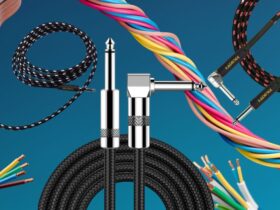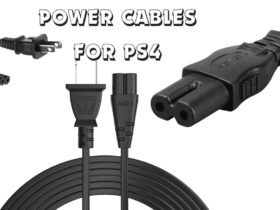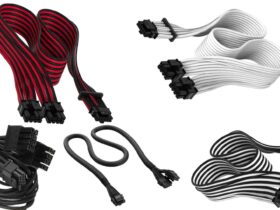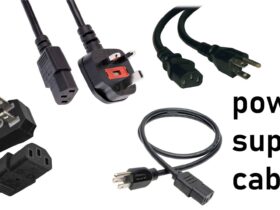Introduction to Trs Cable for Guitar
A TRS cable connects your guitar to an audio interface or amplifier. This cable helps transmit your guitar’s signal without any interference.
When it comes to playing guitar, having the appropriate gear is crucial for achieving optimal sound quality. One essential component is the TRS cable. This type of cable connects your guitar to either an audio interface or an amplifier.
This cable makes sure the signal from your guitar goes through without any problems, so you get clear and great sound. Picking the right TRS cable is important for musicians.
It can change how your guitar sounds and performs. Let’s talk more about why using a TRS cable for your guitar matters and give some advice on how to choose the best one for what you need.
What Is A Trs Cable for guitar?
Trs Cable for Guitar is an essential component in the world of audio equipment, especially for guitarists. Understanding what a TRS cable is is important.
This type of cable has three components. People use it for various purposes. TRS stands for Tip, Ring, and Sleeve. These components serve different functions. For instance, the tip carries the audio signal. Meanwhile, the ring often carries a phase-reversed version of the same signal.
Finally, the sleeve serves as the grounding connection, indicating that each component has a distinct purpose. Knowing this can help you set up your audio equipment correctly.
Moreover, understanding its common uses is beneficial. Many audio devices like headphones, microphones, and musical instruments use TRS cables. They are versatile and reliable. Therefore, learning about TRS cables and their uses can improve your audio experience.
Definition of Trs Cable for Guitar
Trs Cable for Guitar, which is short for Tip-Ring-Sleeve cable, has three separate parts. These parts, called conductors, don’t make contact with each other. Each conductor does its job.
The Tip part carries the audio signal. Then, people often use the Ring part for a second audio signal or stereo. Finally, the Sleeve part is where both signals come back together to complete their journey.
Components
- Tip: Carries the audio signal
- Ring: Used for a second audio signal or stereo
- Sleeve: The ground or common return for both signals
Common Uses
People often use Trs Cable for Guitar to connect audio equipment. This includes instruments like guitars and keyboards. They are also handy for linking studio monitors and audio interfaces.
In addition, people commonly use Trs Cable for Guitar in balanced audio setups. This is especially important in studios where reducing interference and noise is vital.
Importance Of Trs Cable For Guitar
Having good sound is super important when you’re playing guitar. To ensure clear sound without any problems, you need the right cable. The TRS cable helps there
Guitarists need TRS cables because they stop annoying sounds and make the guitar sound better. So, let’s take a closer look at why Trs Cable for Guitar is so important for guitarists.
Optimal Audio Transfer
When you connect with a Trs Cable for Guitar, you get the highest quality sound. This happens when you connect your guitar to things like an audio interface or amplifier. The TRS cable is balanced, which means it sends the audio signals without messing them up. So, your voice sounds really clear and perfect.
Reduced Interference
Trs Cable for Guitar design helps in reducing interference by effectively canceling out any extraneous noise or electrical interference. This is especially helpful in recording studios or during live shows. That’s because there can be background noise that you don’t want, which can make the music less enjoyable.
Increased Flexibility
One big advantage of using a Trs Cable for Guitar is that it’s flexible. You can do more with it than just connecting your guitar to an amplifier. You can also use these cables to connect other audio gear like effects pedals, mixing consoles, and other stuff. This gives guitarists a lot of options in different situations.
Different Types Of Trs Cables
People commonly use Trs Cable for Guitar also known as Tip-Ring-Sleeve cables, in audio applications, particularly for guitars. They are essential for connecting guitars, amplifiers, pedals, and other audio equipment.
Trs Cable for Guitar comes in various types, each serving different purposes and offering distinct features. Understanding the different types of TRS cables can help you make the right choice for your specific audio needs. In this blog post, we will explore the following types of TRS cables: Balanced TRS Cable, Unbalanced TRS Cable, and TRS to XLR Cable.
One of the most popular types of Trs Cable for Guitars is the Balanced TRS Cable. It transmits balanced audio signals, reduces interference and noise, and provides cleaner and clearer sound.
The balanced TRS cable has three conductors: the tip (positive signal), the ring (negative or inverse signal), and the sleeve (ground). Professionals often use this cable in audio setups such as recording studios and live shows. It holds significance there as it contributes to maintaining high sound quality.
Another commonly used type of Trs Cable for Guitar is the Unbalanced TRS Cable. The unbalanced TRS cable transmits unbalanced audio signals, unlike the balanced TRS cable. It has two conductors: the tip (signal) and the sleeve (ground).
People widely use unbalanced Trs Cable for Guitar in home audio systems, personal recording setups, and other non-professional applications. They are suitable for shorter cable runs and situations where noise rejection is not a major concern.
TRS to XLR
A TRS to XLR cable is a variant of the Trs Cable for Guitar designed for specific purposes. It changes a balanced TRS signal to an XLR signal and the other way around. XLR connectors are often on pro audio gear, like microphones and mixers.
This cable is handy when you have to connect gear with different connectors. People use TRS to XLR cables a lot in places like recording studios and live sound setups.
In summary, learning about the different types of Trs Cable for Guitar can help you choose the right one for your audio needs. If you’re setting up professional audio gear, you might need a balanced TRS cable. However, for personal usage, an Irregular TRS cable might be suitable.
If you require linking various equipment types, consider using a TRS to XLR cable. So, when you’re selecting a TRS cable, think about what your audio setup needs, and choose the one that fits best.
Choosing The Right Trs Cable for Guitar
When you connect your guitar to an amplifier or audio interface, you need the right TRS cable. This type of cable, commonly used in music, has three parts and effectively transmits signals. Today, we’ll discuss key considerations for selecting the appropriate TRS cable for your guitar configuration.
Length Considerations
Considering the length of your Trs Cable for Guitar is crucial. Although you might want a long cable, remember that too much length can make the signal weaker and lower the sound quality. But if the cable is too short, you might not be able to move around comfortably on stage or in the studio. So, achieving the appropriate Balance is essential.
For most guitarists, a cable length between 10 to 20 feet (3 to 6 meters) is usually sufficient. This allows for ample movement while minimizing the risk of signal degradation. But if you need to move around a lot, you can use a longer cable, but remember it might weaken the signal.
Connector Types
When considering TRS cables, there exist various connector types available for selection. The most common connector types are:
| Connector Type | Advantages | Disadvantages |
| 6.35mm (1/4 inch) TRS | Compatible with most guitars, amplifiers, and audio interfaces. | Relatively larger size and less commonly used in certain audio equipment. |
| 3.5mm (1/8 inch) TRS | Compact and commonly used with headphones and portable devices. | May require adapters for connection to larger audio equipment. |
When you’re picking a connector, make sure it works with your guitar and other devices. If you usually play electric guitar and use regular guitar amps and audio interfaces, go for the 6.35mm TRS connector—it’s the usual one. But if you often connect your guitar to headphones or small devices, you might find the 3.5mm TRS connector better.
Cable Quality
Lastly, the quality of the TRS cable itself is vital for achieving optimal sound reproduction. Poorly constructed cables can introduce noise, interference, and signal loss. Opting for a high-quality cable ensures clean and accurate signal transmission.
Look for cables that feature:
- High-quality shielding to minimize interference.
- Durable connectors that provide a secure and reliable connection.
- Thick and robust cables that are resistant to wear and tear.
Buying a good TRS cable might cost a bit more at first, but it can stop you from having sound problems later on and from having to buy new cables all the time.
How To Connect A Guitar Using A Trs Cable
If you’re a guitarist aiming to optimize your sound, understanding the Usage of a TRS (Tip, Ring, Sleeve) cable is crucial. This specialized cable serves as a convenient means to connect guitars with amplifiers or audio equipment.
It assists in maximizing your guitar’s potential. In this guide, we’ll show you step-by-step how to connect your guitar using a TRS cable. We’ll begin at the point where you connect the cable to your guitar and provide guidance in case any issues arise.
Step 1: Guitar Output Jack
To start, find the output jack of the guitar. You typically find this on the instrument’s body, and it’s where the cable connects. With your TRS cable in hand, insert the tip of the cable into the corresponding jack on your guitar.
Depending on your guitar model, you may need to push the jack in firmly or twist it slightly to ensure a secure connection. Once you connect it, you’ll hear a satisfying “click” sound, confirming that you’ve properly plugged in the cable.
Step 2: Amplifier Or Audio Interface Input
After that, find the input jack on your amplifier or audio interface. Most amplifiers and interfaces have a label or picture showing an audio jack for this input.
Now, insert the other end of the Trs Cable for Guitar into the input jack on your amplifier or audio interface. Make sure you’re connecting it to the right channel or input you want to use. Again, push the cable in firmly or twist it slightly as needed to ensure a secure connection.
Step 3: Troubleshooting Tips
After you’ve connected your guitar with the TRS cable, you’re all set to begin playing. However, if you encounter any issues with the sound or Relationship, here are a few troubleshooting tips to help:
- Check the cable: Ensure that the TRS cable remains undamaged or unworn. If there are any visible signs of wear, it may be necessary to replace it.
- Clean the connections: Over time, dust and debris can build up on the input jacks of your guitar, amplifier, or audio interface. This buildup can cause problems like crackling sounds or poor connections. So, it’s important to regularly clean these jacks to maintain good audio quality. Use a clean cloth or compressed air to remove any dirt that might be obstructing a proper connection.
- Test with another cable: If you have access to another TRS cable, try using it to connect your guitar. This will help determine if the issue lies with the cable or with the equipment itself.
- Check the guitar’s settings: Make sure you set the volume and tone controls on your guitar to an appropriate level. Adjusting these settings can often solve issues related to sound quality or volume.
Follow these steps, and remember these tips to troubleshoot. In this manner, you’ll securely link your guitar using a TRS cable. Then, you can enjoy an even better playing experience. Whether you’re playing music in your bedroom or recording in a fancy studio, using a TRS cable will ensure your sound is top-notch.
Common Trs Cable Issues And Solutions
Guitar setups commonly use a TRS cable, also known as a balanced cable, to transmit audio signals. However, like any other cable, TRS cables are not immune to issues that can affect their performance. In this segment, we will discuss prevalent problems encountered with TRS cables and methods for resolving them.
First, let’s identify some of the problems you might encounter. Then, we’ll delve into solutions that can help you troubleshoot and resolve these issues effectively. Whether you are experiencing cable noise, connection problems, or wire damage, we’ve got you covered.
Cable Noise
Cable noise can be an annoying issue that affects the sound quality of your guitar. This buzzing or humming sound may occur for various reasons:
- Poor grounding can cause your TRS cable to pick up interference from surrounding electrical sources, resulting in cable noise.
- Loose connections: Loose connections can also contribute to cable noise. Make sure you securely plug your TRS cable into the guitar, amplifier, or other audio equipment.
- Low-quality cables: Using low-quality TRS cables can introduce unwanted noise into the audio signal. Investing in high-quality cables can significantly reduce cable noise.
To resolve cable noise issues:
- Check the grounding: Ensure you securely connect the ground and properly ground all components in your setup. This can help eliminate unwanted interference.
- Tighten connections: Make sure that all connections, including the TRS cable connections, are tight and secure. A loose connection can introduce noise into the signal.
- Upgrade your cables: Consider investing in high-quality TRS cables with proper shielding. We design these cables to minimize interference and reduce cable noise.
Connection Problems
Connection problems can disrupt the signal flow between your guitar and audio equipment. These problems can manifest in various ways:
- No signal: If your guitar isn’t making any sound with the Trs Cable for Guitar, there might be a connection problem.
- Intermittent signal disruptions on your guitar may stem from a defective connection.
- Crackling or popping sound: A crackling or popping sound can indicate a connection issue or a faulty cable.
To troubleshoot and resolve connection problems:
- Check all connections: Ensure that all connections, including the TRS cable connections, are secure and properly plugged in. Loose or faulty connections can cause signal problems.
- Inspect for cable damage: Examine the TRS cable for any signs of physical damage. Bent or frayed connectors, exposed wires, or kinks in the cable can all affect the connection.
- If you think the cable might be causing the problem, try using another TRS cable. See if the connection issues continue. This will help you determine if the cable is causing the trouble.
Wire Damage
Over time, the wires inside a TRS cable can sustain damage. This damage can cause problems like signal loss or intermittent connections.
When damage or decay affects the wires, it compromises their functionality. As a result, you might experience issues like your sound cutting in and out. Thus, it’s important to keep an eye on the condition of your cables. Common causes of wire damage include:
When you bend or twist the cable too much, you can break or loosen the wires inside. endlessly repeating the action exacerbates the situation. Please ensure that you avoid excessive bending or twisting of the cable.
- Pulling on the cable: Pulling on the cable, rather than the connector, can strain the wires and damage them.
- Accidental damage: Dropping heavy objects on the cable or mistakenly stepping on it can also result in wire damage.
Here are some solutions for dealing with wire damage:
- Inspect the cable: Regularly inspect your TRS cable for any visible signs of wire damage. Search for exposed wires, frayed connections, or bends and twists in the cable.
- Replace damaged cables: If you notice any wire damage, it is best to replace the TRS cable. Continuing to use a damaged cable can lead to further issues and impact the sound quality.
- Handle with care: Be mindful of how you handle and store your TRS cables. Avoid excessive bending or pulling, and store them properly to prevent accidental damage.
Maintenance And Care For Trs Cables
Maintenance and Care for Trs Cable for Guitar is essential to ensure their longevity and optimal performance. Regular maintenance of your guitar setup is crucial. Neglecting these important components can lead to signal loss and interference. Proper care can prevent such issues.
Proper Storage
When not in use, store Trs Cable for Guitar in a dry, cool area with loose coils. This feature prevents damage and keeps them from tangling. Avoid bending them sharply or causing any kinks in the cable, as this can mess up how the cable works.
It’s advisable to keep them stored in a designated bag or case solely for cables. This safeguards them from potential damage caused by elements such as rain or dust. Therefore, it’s essential to maintain proper care for your cables when they’re not in use.
Cleaning Tips
Keeping your Trs Cable for Guitar in good condition is vital. Dust, debris, and sweat can harm the connections, leading to poor signal quality. Therefore, it’s essential to clean them regularly.
After each use, grab a clean, dry cloth and wipe down the cables. Additionally, make it a habit to inspect the connectors frequently.
Look out for any buildup or corrosion. This simple maintenance routine will help ensure your cables perform well whenever you need them. If necessary, use a small amount of electrical contact cleaner on a swab to gently clean the metal contacts.
Protecting Against Physical Damage
Physical damage can significantly impact the performance of TRS cables. Avoid stepping or placing heavy objects on them, and never yank the cable from the ends. Utilize cable clips or ties to secure the cables and prevent strain on the connectors. Additionally, be mindful of the cable’s placement to avoid tripping hazards or accidental damage.
Troubleshooting Trs Cable Problems
TRS (tip, ring, sleeve) cables are essential components for guitarists, Assisting in the transmission of high-quality audio signals. However, like any electronic equipment, TRS cables can sometimes encounter issues that affect their performance. In this section, we’ll discuss common problems with TRS cables and how to troubleshoot them effectively.
Testing For Signal Loss
The initial step in troubleshooting Trs Cable for Guitar issues involves determining whether there is a signal loss. Start by doing a simple test to see if the cable is sending the signal correctly from the guitar to the amplifier.
Begin by linking the TRS cable from the guitar to the amp. Next, play a few notes to test the sound quality and volume. If the sound quality or volume decreases, we’ll need to troubleshoot further. If you hear any signal loss, you need to figure out what’s wrong and fix it quickly to make sure the audio sounds good.
Identifying Grounding Issues
Grounding problems can significantly impact the performance of Trs Cable for Guitar. Listen for any buzzing or humming noises emitted when connecting the cable to the guitar and amplifier. These unwanted noises are often indicative of grounding issues.
To fix this issue, first, look at the cable closely for any signs of damage. Then, make sure all the connections are tight. If the grounding problems keep happening, you might need to check the inside wiring of the cable to find and fix what’s causing it.
Replacing Connectors
Over time, the connectors of Trs Cable for the Guitar can wear out, leading to Relationship issues. Consider replacing the connectors to restore optimal functionality. Carefully examine the connectors and assess whether there are any signs of damage or degradation. Replacing the connectors with high-quality, compatible alternatives can effectively resolve relationship problems and ensure nonstop signal transmission if detecting any issues.
Advanced Techniques With Trs Cables
TRS cables, also known as Tip-Ring-Sleeve cables, offer a range of advanced techniques for guitarists to explore. You can enhance your guitar-playing experience in various ways by using these versatile cables. In this article, we’ll explore three exciting possibilities enabled by Trs Cable for Guitar.
Initially, let’s delve into the Usage of a TRS cable for achieving stereo sound. Following that, we’ll delve into the establishment of effects loops, which can significantly enhance your musical compositions. Finally, we’ll delve into how you can connect multiple instruments using TRS cables. Alright, let’s delve in and explore these advanced techniques together!
Using Trs Cable For Stereo Output
If you aim to create a stereo effect with your guitar, consider utilizing a TRS cable. You plug one end into your guitar and the other into your stereo amp or audio interface.
This helps create a big, full sound. You can change how your guitar sounds and make it feel like it’s all around you. Whether you’re recording music or performing live, employing a TRS cable can enhance the sound of your guitar.
Creating Effects Loops
Effects loops are a popular choice for guitarists who want to add and control external effects in their signal chain. With TRS cables, you can easily create effects loops and make your guitar sound even more expressive.
To establish an effects loop, start by obtaining a Trs Cable for Guitar. Then, insert one end into the send jack on either your amplifier or pedalboard.
Then, connect the other end to the input of your external effects device. When you use your gear, your signal travels to the effects and then back again. You can control when and how to apply those effects.
Next, you’ll want to connect the output of the effects device back to the return jack of your amplifier or pedal board. This setup lets you insert effects between the preamp and power amp of your amplifier. It gives you more control over your tone and lets you add effects at specific points in your signal chain.
Utilizing Trs Cable For Multiple Instruments
If you play many instruments or are in a band with lots of guitar players, Trs Cable for Guitar can make things easier. Using TRS cables, you can link many instruments to just one amp or audio system without extra gear.
Simply use a TRS cable with a Y-splitter to connect each instrument to the input jack(s). This allows you to switch between instruments seamlessly, giving you more flexibility on stage or in the studio. Plus, it reduces the clutter and confusion of having multiple cables and equipment for each instrument.
Diy Trs Cable Repair And adaptation
Have you ever experienced the frustration of a malfunctioning TRS cable for your guitar? Don’t fret, as there’s a solution available – DIY repair and adaptation of TRS cables. By following a few simple steps, you can save both time and money by fixing or customizing your TRS cable yourself. In this article, we’ll explore three common DIY techniques: replacing connectors, changing cable length, and customizing cable colors.
Replacing Connectors
If you have a TRS cable that’s giving you problems, one of the most straightforward fixes is to replace the connectors. You can easily accomplish this with a few tools and some basic soldering skills. Here’s a step-by-step guide:
- First, gather your materials – a new TRS connector, soldering iron, solder, wire cutter/stripper, and heat shrink tubing.
- Next, carefully remove the old connector by heating the solder joints and gently pulling it off.
- After removing the old connector, strip the cable’s outer insulation to expose the inner conductors.
- Identify the appropriate wires for the tip, ring, and sleeve connections, and strip them as well.
- Next, take the wires and connect them to the right spots on the new connector. Remember to keep the order of connections correct while you do this.
- Solder the connections, then cover each joint with heat shrink tubing and apply heat to seal and insulate them.
- Finally, test your newly repaired TRS cable to ensure it’s working correctly.
Changing Cable Length
Occasionally, a Trs Cable for Guitar might exceed or fall short of your required length. Instead of buying a new cable, you can modify the length of your existing one. Here’s how to do it:
- First, determine the desired length for your TRS cable.
- Using a wire cutter, carefully cut the cable to your desired length, ensuring a clean and straight cut.
- After cutting, strip the cable’s outer insulation to expose the inner conductors.
- Identify the appropriate wires for the tip, ring, and sleeve connections, and strip them as well.
- Now, follow the steps outlined in the previous section, “Replacing Connectors,” to solder the wires to a new connector.
- With your new custom-length TRS cable, you can enjoy a clutter-free setup tailored to your preferences.
Customizing Trs Cable for Guitar Colors
If you desire to personalize your Trs Cable for Guitar, you have the option to select your preferred colors. This is a fun and easy way to add your style. Here’s how:
- Start by determining the colors you want to use for your TRS cable.
- Obtain heat shrink tubing in your chosen colors, ensuring they fit your cable’s diameter.
- Carefully slide the heat shrink tubing onto the cable, leaving the desired length exposed.
- Apply heat evenly to the tubing using a heat gun or lighter to shrink and secure it onto the cable.
- Repeat the process for each section of the cable, using different colors as desired.
- Once you’ve got your TRS cable customized, you’ll have a strong connection that you can count on. Also, it’ll look nice with your guitar setup.
Upgrading From Trs To Trs-xlr Cables
If you play the guitar and want to make your sound better, switching from TRS to TRS-XLR cables could help. People commonly use TRS cables for guitars and other equipment. However, choosing TRS-XLR cables can provide even more benefits. Let’s discuss optimal times for upgrading, the advantages of XLR connections, and techniques for transitioning from TRS to XLR.
When To Consider Upgrading
If you’re wondering whether it’s time to upgrade your Trs Cable for Guitar to TRS-XLR, several factors can help you make the decision. Here are a few situations in which upgrading can greatly benefit your guitar-playing experience:
- Your current sound quality lacks clarity and depth
- You frequently perform in venues with professional audio systems
- You want to ensure a reliable and noise-free signal transmission
- You desire to have more control over your guitar’s tone and dynamics
Benefits Of Xlr Connection
1. Improved Sound Quality: When you switch to TRS-XLR cables, you get better sound. That’s because they improve the quality. XLR connections transmit a clean and balanced audio signal, resulting in a clearer and more defined tone.
2. Noise Reduction: XLR cables minimize electrical interference and noise, making them ideal for stage performances and recording situations. By upgrading to TRS-XLR cables, you can significantly reduce unwanted hums, hisses, and buzzes in your audio signal.
3. Long-Distance Transmission: TRS-XLR cables let you use longer cables without losing any sound quality. This means your guitar will always sound just as good, even on big stages.
4. Range: XLR connections work with professional audio gear and let you connect your guitar to lots of different things. You can plug into mixers, audio interfaces, and PA systems, giving you lots of options.
Adapting Trs To Xlr
If you already have Trs Cable for Guitar and don’t want to buy new TRS-XLR cables, you can use adapters or converters. These devices change the TRS signal so it works with XLR connections, letting you use XLR without getting new cables.
Switching from TRS to TRS-XLR cables can make your guitar sound better. You’ll get better sound quality, less noise, and more connection options. Whether you’re playing on stage or recording, upgrading to TRS-XLR cables is a smart choice. It will make your music sound even better.
Popular Trs Cable for Guitar Brands
When it comes to choosing a TRS cable for your guitar, having a reliable and high-quality brand is essential. In this section, we will explore three popular TRS cable brands that have gained popularity among guitarists worldwide. These brands have proven to deliver excellent performance, durability, and value for money. Let’s take a closer look:
1. (Orange)
Orange demonstrates exceptional craftsmanship and attention to detail. They design their TRS cables to ensure clear and balanced audio transmission, delivering your guitar’s sound accurately.
These Trs Cable for Guitar withstand the rigors of frequent performances and rehearsals with their rugged construction and reinforced connectors. Whether you are a professional musician or an aspiring guitarist, Orange TRS cables offer reliability and top-notch performance.
#Orange Crush 10′ Instrument Cable with Straight to Straight Connector

| Brand | Orange |
| Compatible Devices | Speaker |
| Colour | Orange |
| Connector Gender | Male-to-Male |
| Data Transfer Rate | 6 Gigabits Per Second |
- Orange Shield Cable SS Phone Cable 3m
2. (GLS Audio)
GLS Audio stands out as the preferred option for numerous guitarists, offering exceptional value without sacrificing quality. Their TRS cables are perfect for beginners and Middle guitarists who are conscious of their budget.
GLS Audio cables offer excellent sound quality despite their affordable price. Plus, their durable construction ensures they resist easy breakage. The connectors are sturdy, ensuring a secure and stable connection to your guitar and amplifier. If you are looking for a reliable TRS cable that doesn’t break the bank, GLS Audio has got you covered.
#GLS Audio 20-Foot Guitar Instrument Cable

| Brand | GLS Audio |
| Compatible Devices | Guitar |
| Colour | Yellow |
| Connector Gender | Male-to-Male |
| Shape | Round |
- Durable: Built to last, our electric guitar cord is made with high-quality oxygen-free copper
- Flexible: Our supple guitar chord is designed to coil neatly, preventing twists and tangles
- Premium Quality: Designed with the finest materials, our electric guitar cable features 1/4″ tips
- Low Noise: Double insulator shields for maximum isolation, our TS cable has low capacitance
- Braided Tweed: Our guitar cables are braided in a flexible tweed cloth jacket for durability
3.(KEBILSHOP)
KEBILSHOP is synonymous with innovation and cutting-edge technology. They have pushed the boundaries of TRS cable design to deliver exceptional performance and reliability.
They craft their cables using high-quality materials. This feature prevents the sound from getting lost or distorted. When you connect your guitar, the sound emerges with remarkable clarity and quality.
At KEBILSHOP, they make TRS cables. These cables bend easily and avoid tangling. They excel in live performances and are well-suited for onstage use. If you are a professional guitarist seeking the ultimate TRS cable experience, look no further than KEBILSHOP.
#KEBILSHOP-6.35mm Guitar Cable 1/4 Inch Guitar Instrument Cable

| Brand | KEBILSHOP |
| Compatible Devices | Keyboard |
| Special Feature | Noise Free |
| Colour | Red |
| Connector Gender | Male-to-Male |
- 1/4 inch TS 6.35mm Mono Cable is compatible with the standard 6.35mm interface, such as Mixer, Amplifier, Keyboard, Microphone, Effector, Equalizer, Electronic Organ, Electric Guitar, Electric Bass, Pro Audio, etc.
- 24AWG Oxygen-Free-Copper conductor with insulation, and foil & filling with tensile cotton combine to provide noise-free and precise signal transmission
- 6.35mm to 6.35mm cable, more excellent conductivity, suitable for electric guitar, bass, keyboards, electronic drum to amplifier or other instrument connecting.
- This Guitar Instrument Cable is a 20 ft, This series has a variety of sizes to choose from
Frequently Asked Questions Of Trs Cable For Guitar
Lastly, it’s important to note that employing a TRS cable can be very beneficial. This type of cable allows you to effortlessly link up with various devices or gear in your audio arrangement. It consists of three conductors that carry the audio signal, ground, and return. The tip carries the left channel, the ring carries the right channel or a balanced signal, and the sleeve is the ground.
Yes, you can use a TRS cable for your guitar. People commonly use TRS cables for guitars, particularly when connecting to certain effects pedals or studio equipment. They provide a reliable connection and can help minimize interference or noise.
Using a TRS cable for your guitar can offer several advantages. Firstly, it allows for balanced audio signals, which can help reduce unwanted noise and interference. Secondly, TRS cables are durable and can withstand frequent use, making them ideal for live performances or gigs.
Lastly, it’s worth noting that employing a TRS cable can be highly beneficial. It lets you easily connect to all sorts of devices or equipment in your audio setup.
Conclusion
Purchasing a quality TRS cable for your guitar is a wise decision. This cable facilitates a strong connection for your guitar while ensuring minimal unwanted noise. Plus, it makes your guitar sound even better and improves how it performs. Selecting the appropriate TRS cable can significantly influence your music-making experience, whether it’s a profession or a hobby.
Okay, first, do your research. Following that, consider precisely what you require. Subsequently, select a cable that possesses strength, and flexibility, and excels at transmitting signals effectively. Upgrade your guitar’s setup with a top-notch TRS cable and enjoy a seamless playing experience.










1 Comment